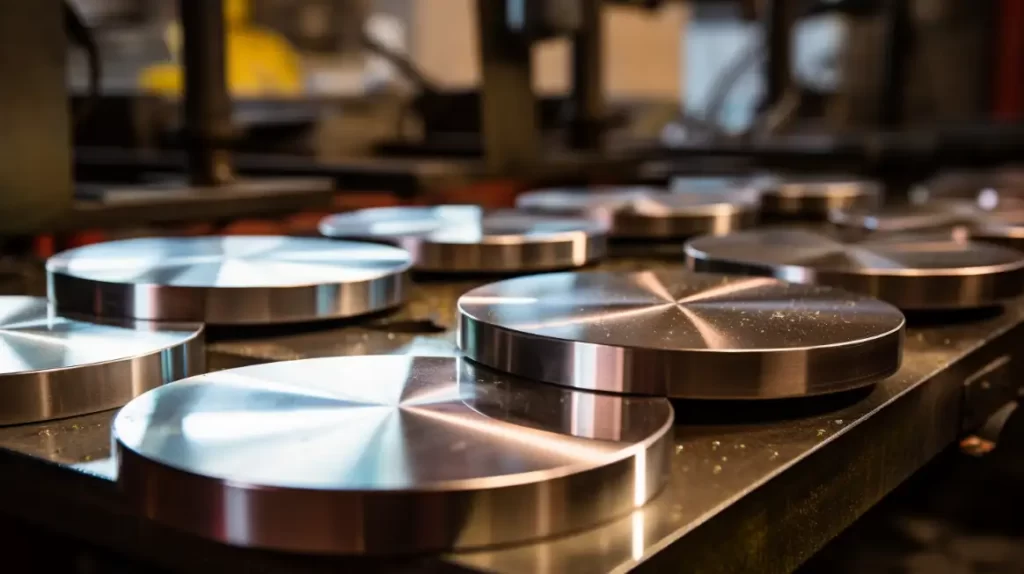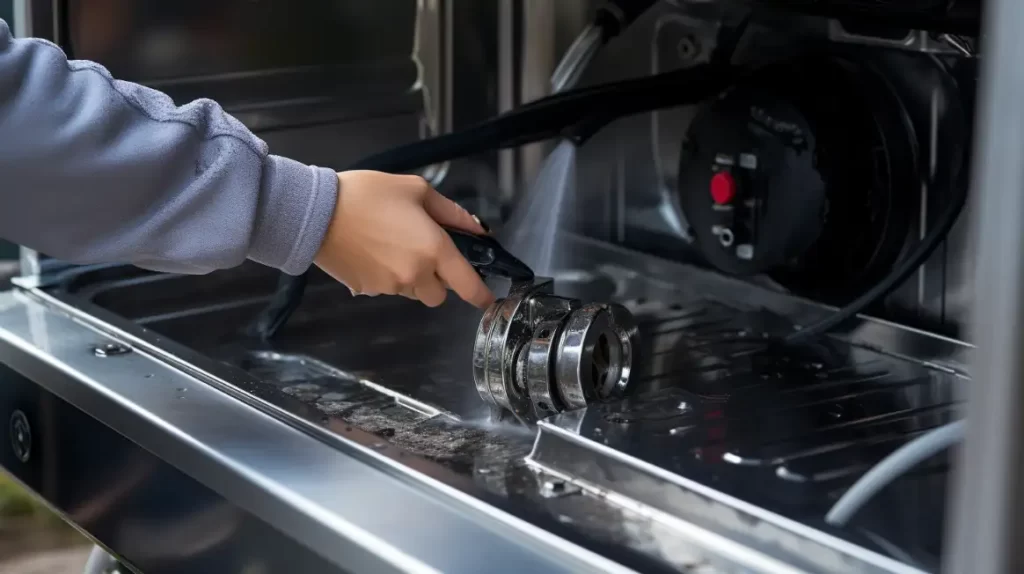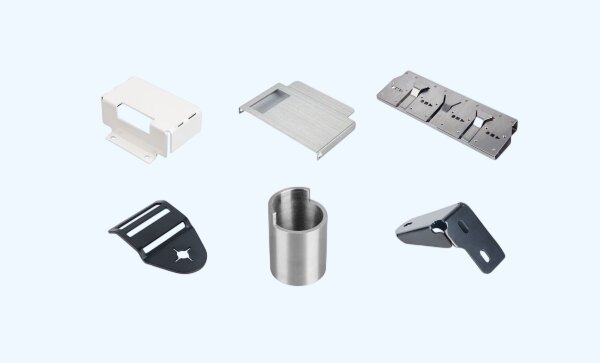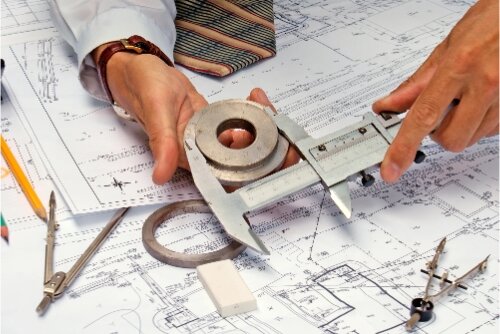الفولاذ المقاوم للصدأ مقاوم للتآكل، ولكنه ليس منيعاً. فالملوثات الناتجة عن التصنيع والمناولة يمكن أن تجعله عرضة للصدأ. قد يكون التخميل هو الحل إذا ظهر على أجزاء الفولاذ المقاوم للصدأ علامات تغير اللون أو التآكل. تعمل هذه العملية على تعزيز مقاومة التآكل وإطالة عمر المكونات الخاصة بك، مما يجعلها خطوة حاسمة في ضمان الأداء على المدى الطويل.
يمكن أن يؤدي تخطي التخميل إلى التآكل المبكر، خاصةً في البيئات القاسية. إذا كان يجب أن تتحمل مكوناتك المصنوعة من الفولاذ المقاوم للصدأ الرطوبة أو المواد الكيميائية أو الظروف القاسية، فإن التخميل يساعد في الحفاظ على سلامتها وأدائها.
ما هو تخميل الفولاذ المقاوم للصدأ؟
تخميل الفولاذ المقاوم للصدأ هو معالجة كيميائية مصممة لإزالة الحديد الحر والملوثات الأخرى من السطح. تعيد هذه العملية طبقة الأكسيد الطبيعية للفولاذ، مما يعزز مقاومته للتآكل.
وعادةً ما تتضمن المعالجة غمر الفولاذ في محلول حمضي، مثل حمض النيتريك أو حمض الستريك، ثم الشطف والتجفيف لضمان الحصول على سطح نظيف ومتين.
لماذا يحتاج الفولاذ المقاوم للصدأ إلى التخميل؟
على الرغم من اسمه، فإن الفولاذ المقاوم للصدأ ليس مقاومًا للبقع تمامًا. أثناء التصنيع والتشغيل الآلي و لحام، يمكن أن تنغرس الملوثات مثل جزيئات الحديد في السطح، مما يخلق نقاط ضعف تؤدي إلى الصدأ.
يزيل التخميل الحديد الحر والملوثات من السطح، مما يمنع تكوّن الصدأ. كما أنه يعزز طبقة أكسيد الكروم الطبيعية، وهي حاجز ضد الأكسدة والتلف الكيميائي.
مبادئ تخميل الفولاذ المقاوم للصدأ
يعمل التخميل على تعزيز مقاومة الفولاذ المقاوم للصدأ للتآكل عن طريق إزالة الشوائب وتعزيز طبقة أكسيد مستقرة. تعتمد العملية على التفاعلات الكيميائية والعوامل البيئية التي تحدد فعاليتها.
التفاعلات الكيميائية وراء العملية
في عملية التخميل النموذجية، تتم معالجة الفولاذ المقاوم للصدأ بمحلول حمضي، مثل حمض النيتريك. يتفاعل الحمض مع جزيئات الحديد الحرة على السطح، مما يؤدي إلى إذابتها وتعزيز تكوين طبقة أكسيد غنية بالكروم. طبقة الأكسيد الجديدة هذه هي ما يجعل الفولاذ المقاوم للصدأ مقاومًا للتآكل.
العوامل التي تؤثر على فعالية التخميل
تؤثر عدة عوامل على نتائج التخميل:
- درجة الفولاذ المقاوم للصدأ: يؤدي ارتفاع محتوى الكروم والنيكل إلى تحسين نتائج التخميل.
- نوع الحمض وتركيزه: تؤثر قوة ونوع الحمض المستخدم (النيتريك أو الستريك) على مدى جودة تنظيف السطح.
- درجة حرارة: يمكن أن تؤدي درجات الحرارة المرتفعة إلى تسريع التفاعل ولكن يجب التحكم فيها لتجنب إتلاف المادة.
- وقت المعالجة: يجب أن تكون مدة الحمام الحمضي كافية لإذابة الملوثات دون الإفراط في تعريض السطح.

طرق التخميل
هناك طريقتان رئيسيتان لتخميل الفولاذ المقاوم للصدأ هما تخميل حمض النيتريك وتخميل حمض الستريك. تعمل كلتا العمليتين على تحسين مقاومة التآكل ولكنهما تختلفان في خصائصهما الكيميائية وتطبيقاتهما.
تخميل حمض النيتريك
في تخميل حمض النيتريك، يتم غمر الفولاذ المقاوم للصدأ في محلول حمض النيتريك المركز. يتفاعل الحمض مع السطح لإزالة ملوثات الحديد مع تعزيز تكوين طبقة أكسيد الكروم. هذه الطريقة فعالة للغاية ولكنها تتطلب معالجة دقيقة بسبب الأبخرة الخطرة الناتجة.
تخميل حمض الستريك
تخميل حامض الستريك هو بديل أكثر ملاءمة للبيئة. يستخدم محلول حامض الستريك لإزالة الملوثات السطحية وتعزيز تكوين طبقة الأكسيد. هذه الطريقة أكثر أمانًا وأسهل في التعامل معها وفعالة بنفس القدر بالنسبة للعديد من درجات الفولاذ المقاوم للصدأ.
المقارنة بين حمض النيتريك وحمض الستريك
- الفعالية: تعمل كلتا الطريقتين على تعزيز مقاومة التآكل بشكل فعال، ولكن حمض النيتريك أكثر قوة في إزالة الحديد الحر.
- تأثير بيئي: يُعد حمض الستريك أكثر صداقة للبيئة وأكثر أماناً في التعامل معه، في حين أن حمض النيتريك يمكن أن ينتج أبخرة ضارة.
- التكلفة والمناولة: يميل حمض النيتريك إلى أن يكون أكثر تكلفة ويتطلب معدات سلامة متخصصة. ويعد حمض الستريك خياراً أكثر فعالية من حيث التكلفة وأكثر أماناً.
- التطبيقات: ويُعد حمض النيتريك أفضل للتخميل في المهام الشاقة، في حين أن حمض الستريك مناسب للاستخدامات الخفيفة حيث تكون المخاوف البيئية أولوية.
فوائد تخميل الفولاذ المقاوم للصدأ
يوفر تخميل الفولاذ المقاوم للصدأ العديد من المزايا الرئيسية التي تساعد في الحفاظ على أداء المادة ومظهرها بمرور الوقت.
تعزيز المقاومة للتآكل
يعمل التخميل على إزالة الملوثات مثل الحديد الحر من السطح، مما قد يؤدي إلى الصدأ والتآكل. يساعد التخميل الفولاذ المقاوم للصدأ على مقاومة الصدأ والأكسدة من خلال تعزيز تكوين طبقة أكسيد واقية.
زيادة المتانة والعمر الافتراضي
تمنع طبقة الأكسيد الواقية المتكونة أثناء التخميل التآكل وتقلل من خطر التنقر أو التشقق أو تدهور السطح.
لمسة نهائية جمالية محسّنة
يحسِّن التخميل أيضًا من صقل الأسطح من الفولاذ المقاوم للصدأ، مما يزيل تغير اللون ويعزز اللمعان الطبيعي للمادة.
الدليل التفصيلي لتخميل الفولاذ المقاوم للصدأ خطوة بخطوة
يتضمن تخميل الفولاذ المقاوم للصدأ عدة خطوات رئيسية لضمان فعالية العملية. فيما يلي تعليمات خطوة بخطوة للتخميل:
الخطوة 1: التنظيف
قبل التخميل، من الضروري تنظيف الفولاذ المقاوم للصدأ جيدًا لإزالة الزيوت والشحوم والأوساخ وبقايا التصنيع قبل التخميل.
الخطوة 2: اختيار طريقة التخميل الصحيحة
عوامل في الاعتبار
عند الاختيار بين تخميل حمض النيتريك وحمض الستريك، ضع في اعتبارك ما يلي:
- نوع الفولاذ المقاوم للصدأ: قد تستجيب السبائك الأعلى درجة بشكل أفضل لطريقة واحدة.
- تأثير بيئي: يُعد حمض الستريك أكثر أماناً وصديقاً للبيئة، بينما يتطلب حمض النيتريك المزيد من احتياطات السلامة بسبب الأبخرة الضارة.
- النتيجة المرجوة: يُعد حمض النيتريك مثاليًا لمقاومة التآكل في المهام الشاقة، بينما يُعد حمض الستريك مناسبًا لاحتياجات المهام الخفيفة.
الخطوة 3: تنفيذ عملية التخميل
المناولة السليمة للمواد الكيميائية
التعامل مع الأحماض باستخدام معدات الوقاية الشخصية المناسبة مثل القفازات والنظارات الواقية وحماية الجهاز التنفسي. تأكد من تخزين الحمض والتخلص منه وفقًا لإرشادات السلامة لتقليل المخاطر الصحية والبيئية.
اعتبارات درجة الحرارة ووقت الغمر في الماء
تعتمد فعالية التخميل على درجة حرارة المحلول ووقت الغمر:
- درجة حرارة: بالنسبة لحمض النيتريك، تكون درجات الحرارة بين 120-140 درجة فهرنهايت (49-60 درجة مئوية) هي الأمثل. يعمل حمض الستريك بشكل جيد في درجة حرارة الغرفة ولكنه قد يستفيد من التسخين المعتدل.
- وقت الغمر: عادة، يجب غمر الأجزاء لمدة 20-30 دقيقة للسماح بوقت كافٍ لحدوث التفاعلات الكيميائية. قد تزيد المدد الأطول من خطر الحفر على السطح أو التلف.
الخطوة 4: إجراءات ما بعد التخميل
الشطف والتحييد
بعد المعالجة بالحمض، يجب شطف الأجزاء جيدًا بالماء منزوع الأيونات لإزالة أي حمض متبقي. بالنسبة لتخميل حمض النيتريك، قد يكون من الضروري القيام بخطوة معادلة بمحلول قلوي خفيف لإزالة جميع بقايا الحمض.
التجفيف والفحص
بعد الشطف، يجب تجفيف الأجزاء جيداً لمنع ظهور بقع الماء والمزيد من التلوث. بعد التجفيف، افحص السطح بعناية بحثاً عن أي عيوب أو تغير في اللون أو مناطق تحتاج إلى معالجة إضافية.

صيانة الفولاذ المقاوم للصدأ المخمّد
تعد الصيانة الروتينية ضرورية لضمان استمرار أداء الفولاذ المقاوم للصدأ المخمّد في أفضل حالاته. فالعناية المناسبة ستحافظ عليه مقاومًا للتآكل وجذابًا بصريًا بمرور الوقت.
التنظيف والعناية الروتينية
حتى عندما يتم تخميل الفولاذ المقاوم للصدأ، لا يزال الفولاذ المقاوم للصدأ بحاجة إلى التنظيف المنتظم للحفاظ على سطحه. استخدم منظفات غير كاشطة ومناشف ناعمة لتجنب خدش السطح. للتنظيف الروتيني، تُعد المنظفات الخفيفة أو المنظفات المحايدة الأس الهيدروجيني مثالية.
تجنب إعادة التلوث
تجنب تعريض الفولاذ المقاوم للصدأ المخمل لمواد مثل الزيوت أو الغبار أو جزيئات الحديد أثناء المناولة والتخزين. عند التعامل مع القطع، تأكد من نظافتها واستخدم القفازات لمنع انتقال الزيوت أو الرطوبة من يديك.
وقت إعادة التنشيط
بمرور الوقت، يمكن أن تتحلل طبقة التخميل بمرور الوقت، خاصةً في البيئات القاسية أو إذا تعرض السطح للتآكل المادي. إذا ظهرت علامات تآكل أو تلطيخ، فقد حان الوقت لإعادة التخميل. بالإضافة إلى ذلك، قد تكون إعادة التخميل ضرورية بعد عمليات الإصلاح أو اللحام لاستعادة الطبقة الواقية.
خاتمة
يعد تخميل الفولاذ المقاوم للصدأ أمرًا ضروريًا لتعزيز مقاومته للتآكل والمتانة والمظهر الجمالي. يضمن اتباع الإجراءات المناسبة، واختيار طريقة التخميل الصحيحة، والحفاظ على السطح المعالج أداء المادة على النحو الأمثل، حتى في الظروف القاسية.
هل أنت مستعد لتعزيز طول عمر وأداء منتجاتك المصنوعة من الفولاذ المقاوم للصدأ؟ اتصل بنا اليوم لمعرفة المزيد عن خدمات التخميل لدينا وكيف يمكننا مساعدتك في تحقيق أفضل النتائج لمشاريعك!
الأسئلة الشائعة
كم مرة يجب تخميل الفولاذ المقاوم للصدأ؟
يجب تخميل الفولاذ المقاوم للصدأ عند تصنيعه لأول مرة أو بعد أي عملية لحام أو تشغيل آلي قد تؤدي إلى ظهور ملوثات. التخميل المنتظم غير مطلوب إلا إذا ظهر على السطح تآكل أو تلف.
كيف تزيل التخميل من الفولاذ المقاوم للصدأ؟
يمكن تنظيف الفولاذ المقاوم للصدأ باستخدام محلول حمضي قوي أو طرق كاشطة لإزالة التخميل. يمكن لحمض النيتريك أو عملية الكشط الميكانيكي تكسير طبقة الأكسيد.
كيف يمكنك معرفة ما إذا كان الفولاذ المقاوم للصدأ قد تم تخميله؟
يمكن أن يكشف الفحص البصري عن علامات التخميل مثل سطح أملس ولامع وموحد. يمكنك أيضًا إجراء اختبار تآكل، مثل تعريض الفولاذ لمحلول حمضي خفيف، للتحقق مما إذا كانت طبقة التخميل سليمة وفعالة.
ماذا يحدث إذا لم يتم تخميل الفولاذ المقاوم للصدأ؟
إذا لم يتم تخميل الفولاذ المقاوم للصدأ، فقد يكون أكثر عرضة للتآكل، خاصةً في البيئات القاسية. يمكن أن تتسبب جزيئات الحديد المتبقية على السطح في الصدأ والتدهور بمرور الوقت، مما يؤدي إلى تنقر أو تلطيخ أو حتى تلف هيكلي.
مهلا، أنا كيفن لي

على مدى السنوات العشر الماضية، كنت منغمسًا في أشكال مختلفة من تصنيع الصفائح المعدنية، وشاركت رؤى رائعة هنا من تجاربي عبر ورش العمل المتنوعة.
ابقى على تواصل

كيفن لي
لدي أكثر من عشر سنوات من الخبرة المهنية في تصنيع الصفائح المعدنية، وتخصصت في القطع بالليزر، والثني، واللحام، وتقنيات معالجة الأسطح. كمدير فني في شنغن، أنا ملتزم بحل تحديات التصنيع المعقدة ودفع الابتكار والجودة في كل مشروع.




